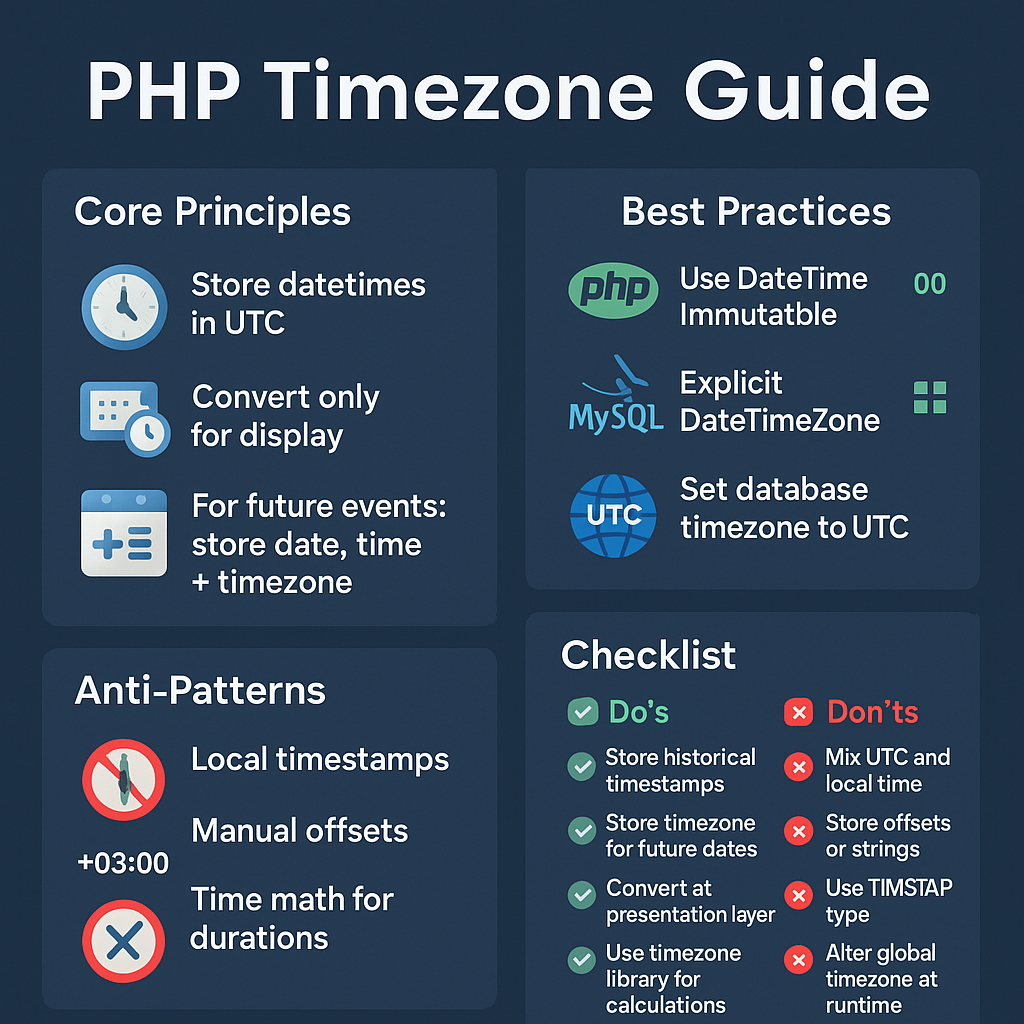
PHP Timezone Guide
Section 1: Foundational Principles of Time Management in Distributed Systems
1.1 The Two Forms of Time: Absolute vs. Civil (Wall Clock) Time
- Absolute Time: A single, unambiguous point on the universal timeline (e.g., Unix timestamp, ISO 8601 UTC). Use for historical events.
- Civil Time: Human-readable local time that varies by location (e.g., “9:00 AM” in Tokyo vs. London). Store for future or recurring events.
1.2 The UTC Imperative: A Single Source of Truth
- Store all historical data in UTC.
- Convert to local time only in the presentation layer.
- Simplifies sorting and comparison across distributed systems.
1.3 Offsets vs. IANA Timezone Identifiers
- Avoid static UTC offsets (e.g., “+08:00”).
- Use IANA identifiers (e.g.,
Asia/Tokyo) for proper DST handling.
1.4 Storing Future and Recurring Events
- Store civil date, civil time, and timezone identifier separately.
- Resolve to UTC just-in-time using latest timezone rules.
Section 2: The Database Layer: MySQL Best Practices
2.1 DATETIME vs. TIMESTAMP
| Feature | DATETIME | TIMESTAMP |
|---|---|---|
| Timezone Handling | Naive | Session-dependent conversions |
| Range | 1000–9999 | 1970–2038 |
| Use Case | Canonical UTC timestamp | Avoid for application data |
Recommendation: Use DATETIME for all absolute timestamps.
2.2 Schema Recommendations
| Concept | Columns | Example | Rationale |
|---|---|---|---|
| Historical Event | created_at DATETIME | ’2024-07-20 15:30:00’ | UTC storage |
| Future Event | event_start_local DATETIME, event_timezone VARCHAR | ’2025-07-04 19:00:00’, ‘America/Chicago’ | Civil time with IANA zone |
| Recurring Event | start_time TIME, timezone VARCHAR, recurrence_rule VARCHAR | ’09:00:00’, ‘Europe/Paris’, ‘FREQ=DAILY’ | Scheduler resolves to UTC |
| Duration | duration_seconds INT | 3661 | Integer arithmetic |
| User Pref | timezone VARCHAR | ’Asia/Tokyo’ | Display conversion |
2.3 Stack Configuration
- MySQL: Set
default-time-zone = '+00:00' - Connection: Always
SET time_zone = '+00:00' - PHP: Set
date.timezone = "UTC"in php.ini
2.4 Database Functions
- Use
UTC_TIMESTAMP()instead ofNOW(). - Use
CONVERT_TZ()only during data migration.
Section 3: PHP Best Practices
3.1 Environment
- Ensure
php.inihasdate.timezone = "UTC"
3.2 Use DateTimeImmutable + DateTimeZone
- Prefer immutable object to avoid side effects
- Always provide explicit timezone
3.3 Code Patterns
- Create UTC:
new DateTimeImmutable('now', new DateTimeZone('UTC')) - From input:
DateTimeImmutable::createFromFormat($format, $value, $tz) - From DB:
createFromFormat('Y-m-d H:i:s', $value, new DateTimeZone('UTC')) - Convert for display:
$utc->setTimezone($userTz)->format(...) - Convert for DB:
$local->setTimezone(new DateTimeZone('UTC'))->format('Y-m-d H:i:s')
3.4 Immutability
- Avoid using
DateTime - Use
DateTimeImmutableto prevent hidden side effects
Section 4: Anti-Patterns and Fixes
4.1 Implicit DateTime and date_default_timezone_set()
- Forbid use of
date_default_timezone_set() - Always instantiate
DateTimeImmutablewith explicitDateTimeZone
4.2 Storing Dates as Text
- Never use
VARCHARto store dates - Use
DATETIMEfor validity and SQL support
4.3 Misusing TIME/DATETIME for Durations
- Store durations as
INTseconds - Format for display in PHP
Section 5: Migration Plan
5.1 Phase 1: Audit
- Inventory all temporal columns (including string or numeric representations)
- Determine intended timezone
- Identify inconsistencies
5.2 Phase 2: Migrate
- Backup
- Add new columns
- Use
CONVERT_TZ()or PHP for transformation - Validate by comparing old and new columns
- Rename, deploy, clean up
5.3 Phase 3: Refactor PHP
- Replace
DateTimewithDateTimeImmutable - Replace
NOW()withUTC_TIMESTAMP() - Eliminate
date_default_timezone_set()
5.4 Phase 4: Validate
- Add tests around timezone correctness
- Manual end-to-end testing
- Add linters/static analysis for banned functions
Section 6: Do’s and Don’ts Checklist
Do’s
- Store UTC for all historical events
- Use
DATETIMEnotTIMESTAMP - Use
DateTimeImmutablewithDateTimeZone - Convert only at presentation layer
- Store future events as civil time + timezone
- Store durations as integers
- Use
UTC_TIMESTAMP()in SQL
Don’ts
- Don’t store timestamps in local time
- Don’t use
TIMESTAMPfor app data - Don’t use
DateTimeor global timezone changes - Don’t use offsets like
-05:00 - Don’t store dates as strings
- Don’t calculate timezones manually
Conclusion
Timezone bugs stem from architectural inconsistency. Standardizing on UTC with IANA identifiers and clearly separating absolute vs. civil time eliminates ambiguity. This guide lays out the strategy, migration, and coding standards necessary to restore predictability, maintainability, and developer confidence in handling time in PHP and MySQL applications.